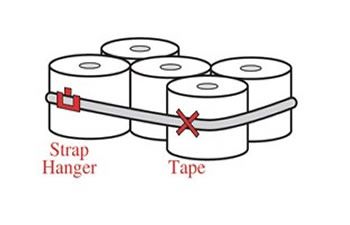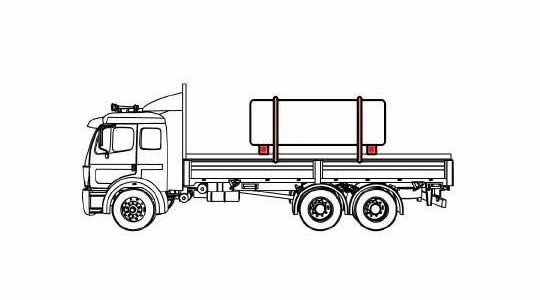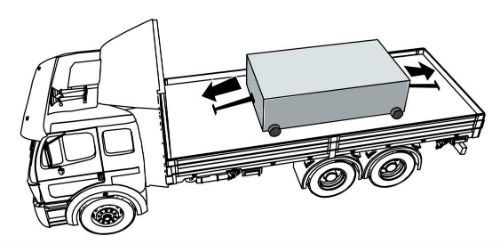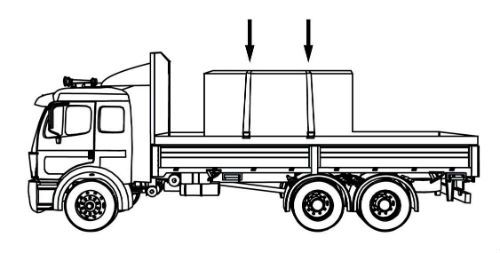CDL Practice Tests: Flatbed Cargo Securement
Choose A Section:
Go!Working Load Limit (WLL)is defined as:
- The acceleration due to gravity, 9.823 m/sec2 (32.2 ft/sec2).
- The maximum load that may be applied to a component of a cargo securement system during normal service, usually assigned by the manufacturer of the component.
- The summation of the working load limits or restraining capacity of all devices used to secure an article on a vehicle.
- The number of hours that a tiedown can be used.
Working Load Limit (WLL):
The maximum load that may be applied to a component of a cargo securement system during normal service, usually assigned by the manufacturer of the component.
Which of the following is not true of Working Load Limit (WLL)?
- All of these are true.
- The Working Load Limit is the maximum load that may be applied to a component of a cargo securement system.
- The WLL is usually assigned by the component manufacturer.
- The minimum WLL requirement for the securement system is 25%.
The Working Load Limit is the maximum load that may be applied to a component of a cargo securement system during normal service.
The WLL is usually assigned by the component manufacturer.
Note: The minimum WLL requirement for the securement system is 50%. More tiedown capacity should be used if you need to secure an article against any movement.
To secure paper rolls with eyes horizontal against rearward movement, you can use which of the following except:
- Blocking.
- The vehicle wall.
- Friction mats.
- Other cargo.
Direction of Potential Movement: Rearward
Methods to Prevent Movement:
- Other cargo
- Blocking
- Fiction mats
- Tiedowns
When banding paper rolls with eyes vertical, you should:
- Secure bands with tape, hangers, or other means.
- Spread rolls apart from each other.
- All of these are necessary.
- Apply bands loosely.
Banding
If paper rolls are banded together:

- Place rolls tightly against each other to form a stable group.
- Apply bands tightly.
- Secure bands with tape, hangers, or other means so that the bands cannot fall off the rolls or slide down to the deck.
The term 'edge protector' refers to:
- A device placed on the exposed edge of an article to distribute tiedown forces over a larger area of cargo than the tiedown itself, to protect the tie-down and/or cargo from damage, and to allow the tiedown to slide freely when being tensioned.
- A structure, device, or another substantial article placed against an article to prevent it from tipping that may also prevent it from shifting.
- A vertical barrier placed directly behind the cab of a tractor to protect the cab in the event cargo should shift forward.
- A rail along the side of a vehicle that protects the side of the vehicle from impacts.
Edge protector:
A device placed on the exposed edge of an article to distribute tiedown forces over a larger area of cargo than the tiedown itself, to protect the tie-down and/or cargo from damage, and to allow the tiedown to slide freely when being tensioned.
In terms of cargo securement, what is a 'well'?
- The depression formed between two cylindrical articles when they are laid with their eyes horizontal and parallel against each other.
- A female housing fixed to the side or ends of a vehicle to receive a stake or peg, and may also be used as an anchor point.
- A device placed between the deck of a vehicle and car or between articles of cargo, intended to provide greater friction than exists naturally between these surfaces.
- A rail along the side of a vehicle that protects the side of the vehicle from impacts.
Well:
The depression formed between two cylindrical articles when they are laid with their eyes horizontal and parallel against each other.
Who is responsible for inspecting securing devices and cargo within the first 50 miles?
- The D.O.T.
- Your Moms.
- The driver.
- The shipper.
Inspect Cargo and Securing devices:
- Pre-Trip: Yes
- Within first 50 mi: Yes
- When duty status of driver changes: Yes
- At 3 hour intervals or every 150 mi, whichever is first: Yes
How much force is the securement system required to withstand in terms of cargo weight?
- 50% forward, 20% rearward, 50% sideways, 20% upwards.
- 80% forward, 50% rearward, 50% sideways, 20% upwards.
- 80% forward, 50% rearward, 80% sideways, 20% upwards.
- 50% forward, 50% rearward, 50% sideways, 80% upwards.
How strong must the vehicle structure and anchor points be?
All elements of the vehicle structure and anchor points must be strong enough to withstand the forces described on page 7.
- Forward force: 0.8 g (80%)
- Rearward force: 0.5.g (50%)
- Sideways force: 0.5 g (50%)
- Upward force: 0.2 g (20%)
An anchor point is defined as:
- The load carrying area of a truck, trailer, or intermodal container.
- Part of the structure, fitting, or attachment on a vehicle or cargo to which a tiedown is attached.
- A vertical barrier across the front of the deck of a vehicle to prevent forward movement of cargo.
- A rail along the side of a vehicle that protects the side of the vehicle from impacts.
Anchor point:
Part of the structure, fitting, or attachment on a vehicle or cargo to which a tiedown is attached.
To secure a cubic-shaped boulder, how many tiedowns are required, at minimum?
- 1
- 3
- 2
- 5
Special Circumstances: Securing a Cubic-Shaped Boulder
The securement of a cubic-shaped boulder must meet these requirements in addition to the other large boulder requirements in Section 13.

Secure each boulder individually with at least two chain tiedowns placed side-to-side across the vehicle.
Place tiedowns as closely as possible to the hardwood blocking used to support the boulder.
About The Flatbed Cargo Securement CDL Manual
Studying the flatbed cargo securement CDL manual is not a requirement for getting your CDL permit or license. It is required knowledge for flatbed drivers.
Some questions you should be able to answer for flatbed cargo securement:
- What is the minimum Working Load Limit of a tiedown used to secure logs?
- What is the minimum weight of a shipment of paper rolls that would require specific securement requirements?
- When securing concrete pipe over 45 inches loaded crosswise, which direction must the tiedowns on the front half of the load run?
- What is a cab shield?
- When securing concrete pipe over 45 inches loaded crosswise, which direction must the tiedowns on the rear half of the load run?
- What is a dunnage bag?
- Who is responsible for inspecting securing devices and cargo within the first 50 miles?
- How many tiedowns are required on a stack of shortwood loaded crosswise?
- What is the minimum working load limit of each tiedown used to secure crushed or flattened vehicles?
- Define 'bolster'
- What is a hook-lift container?
- When a tiedown is attached directly to the cargo, what is the ideal angle where it attached to the vehicle?
What is a securing device?
Any device specifically manufactured to attach or secure cargo to a vehicle or trailer:
- Synthetic Webbing
- Chain
- Wire rope
- Manila rope
- Synthetic rope
- Steel strapping
- Clamps and latches
- Blocking
- Front-end structure
- Grab hooks
- Binders
- Shackles
- Winches
- Stake pockets
- D-rings
- Webbing ratchet
- Bracing
- Friction mat
What is a tiedown?
A combination of securing devices that forms an assembly that:
- Attaches cargo to, or restrains cargo on a vehicle.
- Is attached to anchor point(s).

Some tiedowns are attached to the cargo and provide direct resistance to restrain the cargo from movement.

Some tie-downs pass over or through the cargo. They create a downward force that increases the effect of friction between the cargo and the deck. This friction restrains the cargo.
 Related Cargo Securement Terms That Every Driver Should Know:
Related Cargo Securement Terms That Every Driver Should Know:
-
Tiedown:
A combination of securing devices which form an assembly that attaches cargo to, or restrains cargo on, a vehicle or trailer, and is attached to anchor point(s).
-
Contained:
Cargo is contained if it fills a sided vehicle, and every article is in contact with or sufficiently close to a wall or other articles so that it cannot shift or tip if those other articles are also unable to shift or tip.
-
Blocking:
A structure, device, or another substantial article placed against or around an article to prevent horizontal movement of the article.
How should tiedowns be attached?
Tiedowns can be used in two ways:
-
Attached to the cargo:
- Tiedowns attached to the vehicle and attached to the cargo.
- Tiedowns attached to the vehicle, pass through or aroundan article of cargo, and then are attached to the vehicle again.
-
Pass over the cargo:
- Tiedowns attached to the vehicle, passed over the cargo, and then attached to the vehicle again.
Tiedown placement:

Place the tiedown as close as possible to the spacer.
Position the tiedowns as symetrically as possible over the length of the article.

Position the tiedowns to preserve the integrity of the article.







 TT On Facebook
TT On Facebook